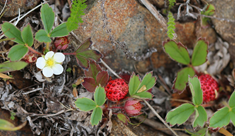
A brief history of the origins of our favorite garden vegetables
Ice on the puddles the other morning had me lamenting the fact that it was still too soon to put starts outside for the season. That got me wondering about the vast number of plants we love to grow in Alaska that aren’t native to our region. Wishing that I wasn’t at the mercy of our climate I asked myself “where do cucumbers grow in the wild?”. Within minutes my curiosity got the better of me. Suddenly, I was feverishly looking up origins for every plant in my greenhouse.
As gardeners it is very easy to plant a seed and only look forward. How many of us garden and look to the past? When you survey your spring planting list do you ever wonder where those plants exist in the wild or how they came into existence? After taking a little time and doing some research I realized how Alaskans are truly global gardeners! Below are highlights from things I learned:
Tomatoes– these South American natives, first domesticated in 500 BC, were brought to the rest of the world by European explorers. Sweet 100’s were first developed by Northrup-King Seed Company in 1978. Early Girls, another hybrid variety, were developed in France and came to America at about the same time. Many of us enjoy cultivating heirlooms, non-hybrid varieties with many decades of proof behind them…but if science rings true all tomato cultivars, hybrid or heirloom, owe their origins to 16 varieties of a single species, Solanum lycopersicum. This article from the UNIVERSITY OF ILLINOIS URBANA‐CHAMPAIGN Cooperative Extension does a great job of explaining tomato origins. If you are interested in the seedy, no pun intended, world of big seed companies, genetics, and the business of seed patents this article on Early Girl tomatoes is worth a read.

Cucumbers– native to India, history suggests they have been cultivated for over 3000 years. Interesting fact, the Spanish brought cucumbers to Haiti in 1494. It is also thought that certain North American tribes cultivated them after trading with Europeans. The ever popular Sweet Success hybrid was first recognized by the AAS ( All American Selections ) when submitted by the Peto Seed Company in 1983. This article from North Carolina State details cucumber research that has been on going since the late 1960’s.

Turnip – originates in the wild from Western Asia to Europe. It is thought that turnips were first cultivated in Northern Europe over 2000 years ago.
The history of Brassica – many of our favorite cold crops owe their lineage to a single, loose leaf Brassica. None of these plants occur naturally in the wild, they were all developed by our gardening predecessors over generations. Head cabbage does not appear in European history until the 13th century AD. Broccoli as we know it today was cultivated in Southern Italy and came to America with Italian immigrants in the 19th century. USDA botanist David Fairchild is credited with bringing kale to North America from Croatia in the 19th century. Brussel sprouts, also from the same ancestral parent source, were developed and perfected in Brussels, Belgium, in the 13th century.

This is a great visual that helps explain the history of Brassica. I found this here.
Potatoes – Native to North America, thought to have been domesticated by indigenous people, genetic testing traces all tuber origins to Peru/Bolivia. The American Indian Health and Diet project offers an excellent history of the potato.
Carrots— thought to have originated in Persia (Iran/Afghanistan) . The plants were grown in parts of Europe as early as 2000BC not for the root but for the greens and seeds. European settlers brought carrots to North America in the 17th century.

This picture was taken from the World Carrot Museum.
Butternut squash– originates in Central and South America as a common type of winter squash. Winter squash spread to North America through indigenous trade. Butternut as we know it today owes its beginnings to Charles Legget who developed the variety in 1944.
Strawberries – origins thought to be from multiple places including South America and Europe. The beginnings of today’s common strawberries can be traced to 18th century France when European and Chilean berries were crossed, giving rise to our modern strains.

Lettuce – originally cultivated by the ancient Egyptians. By 1586 the three main types of modern lettuce; loose leaf, head, and romaine were already documented by scholars. Christopher Columbus is credited with bringing lettuce to the Americas.
Spinach – native to central and western Asia, thought to have been introduced from Persia to China over 1500 years ago. Within several hundred years spinach was introduced to parts of Italy and eventually spread across Europe.
Green beans – native to Central and South America with evidence that they have been grown there for thousands of years.
Rutabaga – thought to have originated in Scandinavia, Finland or Russia. First known printed reference was in 1620 by the Swiss botanist Gaspard Bauhin. Came to North America in the early 1800’s.
Garlic – Native to Central Asia and northeastern Iran.
This is only a brief, partial list. I hope it spurs curiosity as to the origins of everything in your garden. Additional information/corrections/comments are welcome and encouraged. Understanding the history of what we grow can only make us better gardeners.
For information on most North American hybrid vegetables – The Cucurbit Genetics Cooperative keeps an extensive list of all North American vegetables and their genetic history. The Cooperative, established in the late 1970’s, stives to maintain the breeding history of many of the hybrids we grow today.
Another good source for hybrid breeding information is the All American Selections site.
For information on North American heirlooms check out this resource.
About Kim Finkle
Twitter •